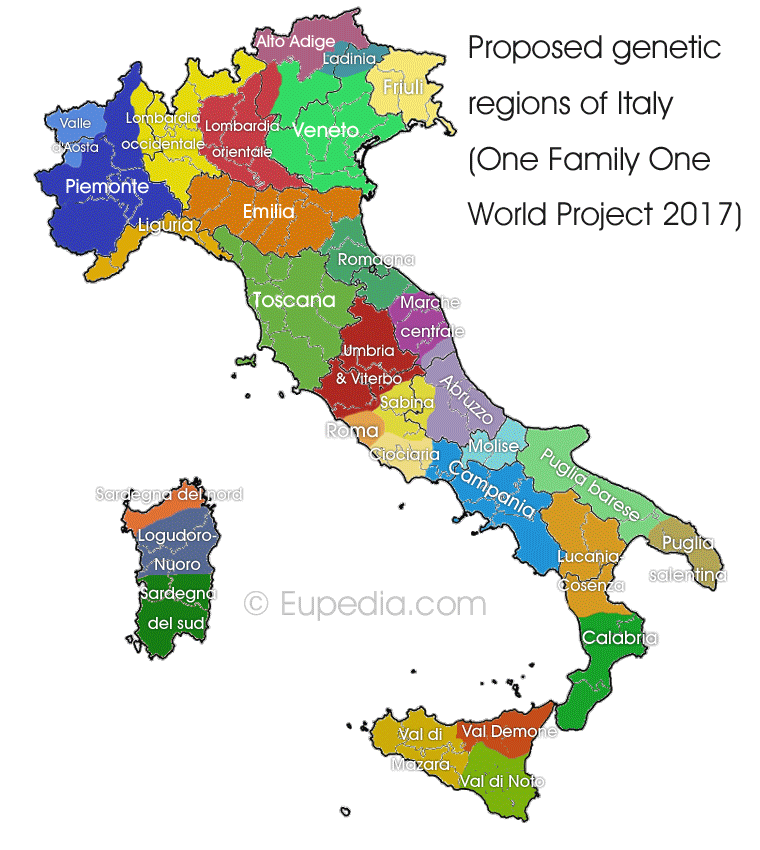One Family Project
The One Family One World Project is a partnership between Living DNA and Eupedia initiated in 2017. The project aims to map the regional genetic variations of the world with a great level of detail and accuracy in order to improve our understanding of both recent and ancient migrations and see how humans are all connected with one another as one big family.
Genetic variations within Italy
Recent genetic studies have shown that Italy has the highest diversity of recent shared genetic ancestry within Europe (Ralph & Coop 2013) as well as an extremely high regional diversity of Y-chromosomal and mitonchondrial DNA (Genetic History of the Italians).
This high heterogeneity can be explained by the unusual geography of the elongated and mountainous Italian peninsula and by the wide range of people who settled there in ancient and medieval times.
Historical context
Northern Italy has been invaded several times by Celtic and Italic tribes from the other side of the Alps, while southern Italy was carved by Greek and Phoenician colonisation. Even Greek colonists didn't all hail from the same region. Some were Ionians from western Anatolia, others Achaeans from the central Peloponnese, or Dorians from other parts of Greece, each settling in specific parts of Sicily or southern Italy.
Rome became the centre of the largest empire Europe had ever known and people flocked to the capital from all over the Mediterranean and western Europe. At present it is not yet clear how much this influx of people to Rome changed the local gene pool compared to other parts of the Latium.
In the 5th and 6th centuries, Italy was overrun by various Germanic tribes like the Goths, the Vandals and the Lombards, who all left genetic traces around the towns and regions where they established themselves, particularly Lombardy, Veneto and Friuli, but potentially also important seats of government like Ravenna, Rome, Spoleto and Benevento.
In the 9th century, Sicily was invaded by the Saracens, who remained on the island for 250 years. In the 9th and 10th centuries, the Normans progressively conquered all of southern Italy and Sicily.
Throughout history Sardinia appears to have been relatively little affected by the various waves of migrations that passed through Italy. While the Romans, Vandals, Goths and Byzantines may all have contributed a bit to the Sardinian gene pool, the population remains very close to that of Late Neolithic Europe, with a noticeable introgression of Levantine DNA in the south, supposedly inherited from the Phoenician colonisation. Northern Sardinia was more recently settled by Corsicans.
Objective & Methodology
To determine the boundaries between proposed genetic regions of Italy we took into account the areas of settlements of ancient Nuragic, Celtic, Italic, Greek and Phoenician populations, and the places where the Romans, Ostrogoths, Vandals, Lombards, Normans and Saracens later settled most heavily.
We believe that the historical borders of counties and duchies, natural barriers (rivers, mountains), as well as the perimeters of the various dialects also influenced the way genes spread in the population over time, as people tended to marry much more frequently within the confines of their geographic, political and linguistic boundaries.
Lombardy, the Marches, Latium, Apulia, Calabria and Sardinia were divided by dialect zones.
Each of the proposed regions represent potentially distinct historical ancestral groups. For example, South Tyrol only became part of Italy in 1919 and is still for the most part ethnically Austrian, while Aosta Valley should be genetically closer to Savoy in France.
A special region was created for the Ladin speakers in the Dolomites of South Tyrol.
The aim of the project is to confirm whether the proposed genetic boundaries are correct, and redefine them if necessary based on the actual genetic data collected from participants in each region.
Proposed genetic regions of Italy
Our preliminary research indicates at least 30 areas of Italy may have distinct genetic differences.

- Abruzzo
- Barese Apulia
- Calabria
- Campania
- Central Marches
- East Lombardy
- Emilia
- Friuli
- Ladinia
- Liguria
- Logudoro-Nuoro
- Lucania-Cosenza
- Molise
- North Sardinia
- Piedmont
- Romagna
- Roman Campagna (Ciociaria)
- Rome
- Sabine Hills (Sabina)
- Salentine Apulia
- South Sardinia
- South Tyrol (Alto Adige)
- Tuscany
- Umbria & Viterbo
- Val Demone
- Val di Mazara
- Val di Noto
- Valle d'Aosta
- Veneto
- West Lombardy
How do I qualify?
The One Family project is open to everyone worldwide and has two parts.
- 1. To build a genetic family tree of everyone from around the world, regardless of where your family comes from.
- 2. To build a regional genetic breakdown of ancestry within countries, similar to 'The Peopling of the British Isles project'. This part of the project is looking for people with all four grandparents born within 80km (50mi) of each other inside our project areas of interest.
If you have already tested with Living DNA, all you need to do to join the project is log into your account, click on the Research tab and choose to participate in our global ancestry research project, if you haven't already done it.
If you already tested your DNA with another company (23andMe, AncestryDNA, MyHeritage, or FTDNA's Family Finder), you can join the project here for free. After submitting the form with your family information, you will receive an email to confirm the creation of your Living DNA account and will be asked to upload your genome there for free.
If you have not yet tested your DNA with one of the above companies, then you will need to order a Living DNA test to take part.
The data provided as part of the project is kept strictly private and confidential under Living DNA’s ISO:27001 certification for information security. Please read Living DNA's Privacy Policy for more information.
See also
